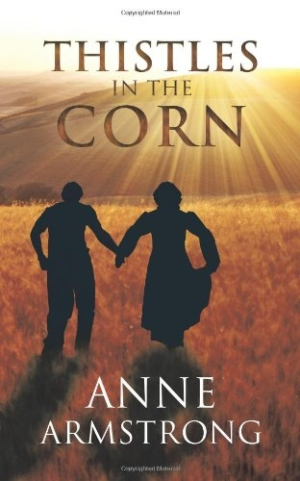Thistles in the Corn
“There be allus summat as’ll come along to spoil things.” In Thistles in the Corn, by Anne Armstrong, the idea that happiness and good fortune never last is as true for farmer Ephraim Stower’s corn crop as it is for Will Smythe, the orphan he “adopted” from the Poor House.
Although Will hopes that he and his wife, Betsy, will inherit the Stower farm in rural nineteenth-century England, Ephraim never makes that promise binding with a will. Stower’s only relative inherits and quickly sells the farm, leaving the Smythe family with no sure means of support. Will is able to find work and shelter at Honeybottom Farm, but unhappiness follows his struggling family. In desperation, he joins a “gang of journeymen,” which offers some economic security at a price. He must leave his wife and growing family behind for months at a time. Although Will’s absence ensures an income, his time away from his family becomes a physical and emotional burden for all. The terrible conclusion of this morality tale evolves from Will’s decision. All is lost just as the family achieves some economic security and contentment.
By the end of the novel the main characters have earned the reader’s sympathy. They have endured numerous hardships and managed to maintain their family. Through most of the novel Will and Betsy seem mere caricatures of rural laborers caught in the first wave of industrialization of the 1840s. Their actions are predicable, and their feelings are stated rather than revealed through their thoughts. Other characters are also two-dimensional. Mrs. Stower, the farmer’s wife, can be relied on to lovingly chide her “bandied legged” husband and to repeat that she was never able to have her own children when Will is part of the conversation. The author depends on local dialect to make her characters believable.
In the second half of the book and especially in the final chapters, the story unfolds in a more fully realized way. Though the resolution is foreseeable, the reader does share the neighbors’ sense of dread and pity for the unfortunate family. The author’s reliance on dialogue to advance the narrative is most effective in the closing scenes, where Will’s life on the road collides with his life at home.
Thistles in the Corn has an air of authenticity. Anne Armstrong has spent her entire life in the villages of Berkshire, England, and she is descended from agricultural workers on both sides of her family, making her intimately familiar with the history of the region and farm life. Her first language was the Berkshire dialect spoken by the chief characters of Thistles in the Corn. By studying her own family history and the Parish Registers of nearby villages, she developed an understanding of the struggles faced by the area’s earlier residents. Her appreciation of these facts and empathy with agricultural workers are evident in her book.
Reviewed by
Geraldine Richards
Disclosure: This article is not an endorsement, but a review. The publisher of this book provided free copies of the book and paid a small fee to have their book reviewed by a professional reviewer. Foreword Reviews and Clarion Reviews make no guarantee that the publisher will receive a positive review. Foreword Magazine, Inc. is disclosing this in accordance with the Federal Trade Commission’s 16 CFR, Part 255.

